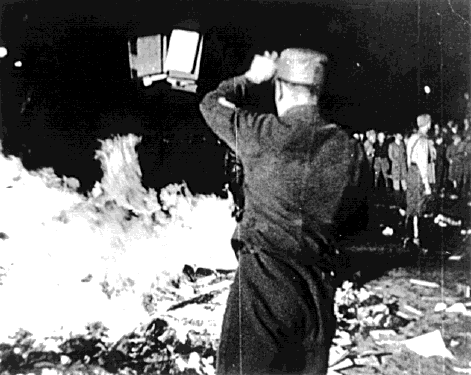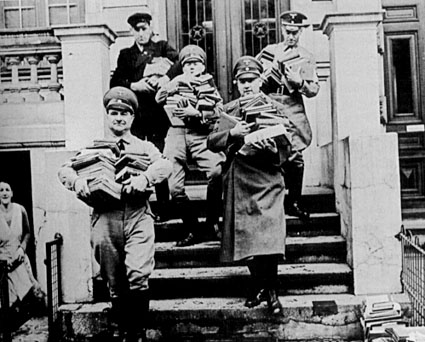The Burning

At 451° Fahrenheit, paper ignites spontaneously.
So Ray Bradbury wrote in his futuristic novel Fahrenheit 451. The main character in Fahrenheit 451 is Montag. Montag is a 'fireman'. But unlike the firemen we're used to, Montag's job is not to put out fires - it's to start them. Montag's job is to burn books.
A hallmark of all repressive regimes is book burning.
In May, 1933, the Nazi party decreed that any book "which acts subversively on our future or strikes at the root of German thought, the German home and the driving forces of our people..." was to be burnt.
We have all seen the pictures of Nazi storm-troopers, their eyes glinting in the fires of burning holy Jewish books.
It is as though they were taking light and returning it to heat. Taking enlightenment and returning it to the dark chambers of emotion.
The nature of evil is to want to turn the light of knowledge into the dark heat of passion. This is a characteristic of the current month: Tammuz is Aramaic for 'heating' (see This Month's Sign).
On the 17th of this month - Shiva Asar B'Tammuz - we commemorate the burning of the Torah by Apostumus Harasha, one of five disasters that occurred on that day.
Although this event is mentioned in the Mishna, the exact details are not known from primary sources. There is, however, an oblique reference in the Jerusalem Talmud:
"Where did he burn it? Rabbi Acha says at Lod, and the other Sages say at the roadways of Taurusa."
The Achronim (later scholars) estimate that the event took place later, during the reign of the Roman proconsul Cumanus, some 16 years before the great Jewish revolt against the Romans, which led to the destruction of the Second Temple under the Emperor Titus.
The historian Josephus Flavius records that this was a time of great hardship for the Jewish People. One Passover, as a result of a Roman soldier indecently revealing himself and swearing at the crowd, 10,000 men were killed in the ensuing violence on the Temple Mount. That Passover, the entire nation mourned.
Shortly after this calamity, robbers attacked and plundered the cortege of a Roman official, Stephanus (Apostumus) on the royal road near Beit Choron.
Cumanus, the proconsul, sent troops to arrest the villagers who lived near the scene of the crime. He held them responsible for not intervening. During the arrest of the villagers, one of the Roman soldiers seized a scroll of the Holy Torah, tore it into pieces, and set it ablaze.
The fury of the Jews knew no bounds. From all directions they came. It was as though the Romans had burned the entire Land of Israel in a holocaust of fire.
Cumanus hanged the soldier publicly to prevent an uprising.
(HEINRICH HEINE 1797-1856)
The 17th of Tammuz marks the first book burning in Jewish history, but it was certainly not the last.
The Franciscan theologian, Alexander of Hales, noted that burning the Talmud would be an appropriate punishment for anti-Christian speech or actions.
Louis IX of France ruled that the Talmud was "full of errors, and that the veil covers the heart of these people to such a degree, that these books turn the Jews... to fables and lies."
In 1242, as a result of this attitude, some 10,000 copies of the Talmud, carried in 24 wagon loads, were burned at the stake before the eyes of grieving Parisian Jews who were kept at bay by royal soldiers. Jewish communities all over Europe mourned this and later destruction of these holy books.
Rabbi Meir of Rothenburg lamented: "O [Torah] that has been consumed by fire, seek the welfare of those who mourn you."
In 1244, Pope Innocent IV ordered Louis IX to again burn the Talmud, and to forbid Jews from hiring Christian nurses or servants. Louis willingly complied.
As late as 1553, under Pope Julius III, Cardinal Peter Caraffa, head of the Inquisition and the future Pope Paul IV, ordered copies of the Talmud burned in the Papal States and all across Italy.
YOU CAN'T BURN FIRE WITH FIRE
 During the Mussaf service
of Yom Kippur, there is a section which describes the death of
the Ten Martyrs at the hands of the Romans. One of the ten was
Rabbi Chananya ben Tradion. The Midrash teaches that he was executed
on the pretext of teaching Torah publicly, a capital offense according
to Roman law.
During the Mussaf service
of Yom Kippur, there is a section which describes the death of
the Ten Martyrs at the hands of the Romans. One of the ten was
Rabbi Chananya ben Tradion. The Midrash teaches that he was executed
on the pretext of teaching Torah publicly, a capital offense according
to Roman law.
He was wrapped in the Torah scroll that he always kept with him, and the Romans set him and the scroll afire. To prolong his agony, they packed his chest with wool soaked in water. Rabbi Chananya said 'The parchment is consumed, but the letters fly up in the air.'
The body of a Jew is like the parchment on which the Torah of his soul is written. Even though the parchment decays, the letters fly up to return to their source.
STONE-FREE
Interestingly, one of the five tragedies that we commemorate on the 17th of Tammuz also involves the letters of the Torah flying back to Heaven.
After receiving the Torah, Moshe came down from Sinai with the first Tablets of the Law. What greeted his eyes was the sight of the people dancing around a golden calf. As a result of this sin, the Jewish People were no longer on a level to receive the Tablets. Thus, the letters took leave of the stone and flew back up to whence they had come.
The Tablets were now unsupported by the letters - the spiritual light that buoyed them up - and grew too heavy for Moshe to carry. Moshe threw down the deadweight stone, and the Tablets smashed on the ground.
AS CLEAR AS BLACK AND WHITE
Two thousand years before the Creation, the Torah existed in its primordial form as black fire on white fire. You cannot burn fire with fire. You cannot burn an idea. The Torah is the 'idea' of Hashem. It is His Will.
The day must come when the Jewish People will be a torch and all the mindless chaff of materialism will finally go up in smoke like so much straw in the biggest bonfire in history!
SOURCES:
- Los Angeles riots August 1965;
- The Book of Our Heritage, Rabbi Eliyahu Kitov, translated by Rabbi Nachman Bulman;
- Mishna Ta'anit 4;
- Flavius Josephus Antiquities Book 20, Chapter 5;
- Beit Halevi Derash 18, Likut on Ki Tisa Shemot 392;
- Robert Michael, University of Massachusetts
This article originally appeared in SEASONS OF THE MOON for Tammuz 5757.






